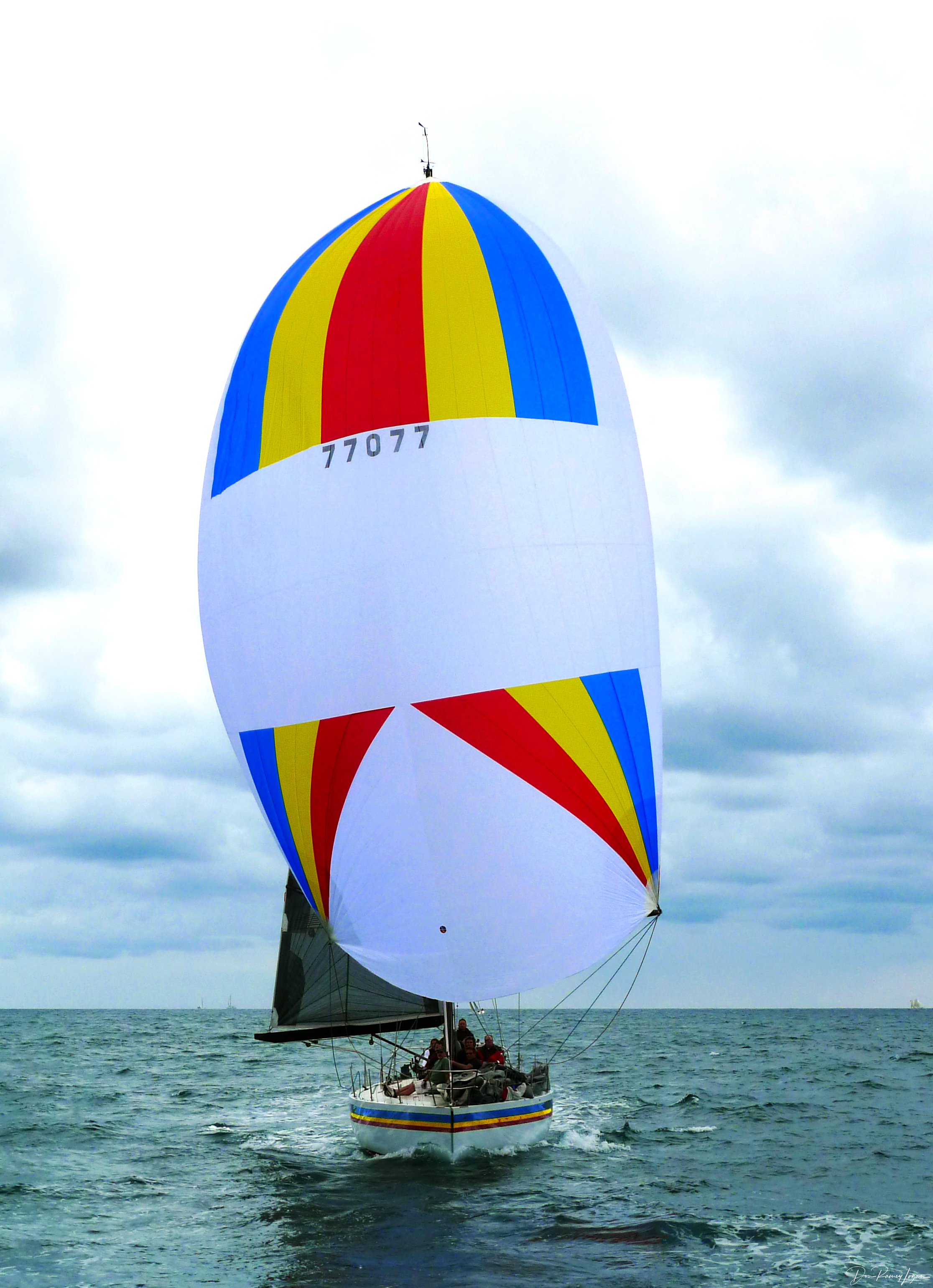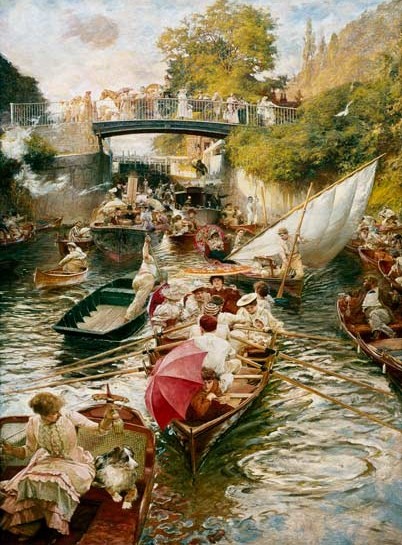|
Musto Skiff
The Musto Skiff is a single-handed sailing skiff with a length of . It features a trapeze, asymmetrical spinnaker, wings and low weight and achieves speeds of over , which makes it one of the fastest single-handed sailing boats. History It was designed in 1999 for the 2000 Olympic Class trials in Quiberon by Joachim Harpprecht, where it won every race in the single-handed dinghy competition. Since then, the class has attained World Sailing international status and is sailed in 20 countries worldwide. It is built by Ovington Boats Ltd in England. At the time of the design, the concept of a single-handed skiff was first met with scepticism by many observers, very similar to the initial reaction after the introduction of the 49er in 1996. The boat remains challenging to sail, and really shows its strengths when raced. World Championships occur annually and regularly usually attract in excess of 70 sailors from over 10 nations. In 2016, the class association agreed to continue i ... [...More Info...] [...Related Items...] OR: [Wikipedia] [Google] [Baidu] |
Monohull
image:monohull.svg, right A monohull is a type of boat having only one hull (watercraft), hull, unlike multihulled boats which can have two or more individual hulls connected to one another. Fundamental concept Among the earliest hulls were simple logs, but these were generally unstable and tended to roll over easily. Hollowing out the logs into a dugout canoe doesn't help much unless the hollow section penetrates below the log's center of buoyancy, then a load carried low in the cavity actually stabilizes the craft. Adding weight or Sailing ballast, ballast to the bottom of the hull or as low as possible within the hull adds stability. Naval architects place the center of gravity substantially below the center of buoyancy; in most cases this can only be achieved by adding weight or ballast. The use of stones and other weights as ballast can be traced back to the Ancient Rome, Romans, Phoenicians and Vikings. Modern ships carry tons of ballast in order to maintain their stabil ... [...More Info...] [...Related Items...] OR: [Wikipedia] [Google] [Baidu] |
Spinnaker
A spinnaker is a sail designed specifically for sailing off the wind on courses between a reach (wind at 90° to the course) to downwind (course in the same direction as the wind). Spinnakers are constructed of lightweight fabric, usually nylon, and are often brightly colored. They may be designed to perform best as either a reaching or a running spinnaker, by the shaping of the panels and seams. They are attached at only three points and said to be ''flown''. Nomenclature Informal names for a spinnaker are ''kite'' or ''chute'' (owing to their resemblance to a parachute in both construction and appearance). Boats may have more than one spinnaker, differentiated by a letter to indicate symmetric (S) or asymmetric (A) and a number to indicate size (with higher numbers indicating smaller size), e.g. ''A1'' would be a large asymmetric sail and ''S3'' would be a smaller symmetric sail. Operation A spinnaker is used for sailing with the direction of the wind. Symmetrical ... [...More Info...] [...Related Items...] OR: [Wikipedia] [Google] [Baidu] |
Ovington Boats , American civil rights activist
{{disambig, geo, surname ...
Ovington may refer to: Places In England: * Ovington, County Durham * Ovington, Essex * Ovington, Hampshire * Ovington, Norfolk * Ovington, Northumberland People with the surname * John Ovington (1653–1731), an English priest * Earle Ovington, American inventor * Mary White Ovington Mary White Ovington (April 11, 1865 – July 15, 1951) was an American suffragist, journalist, and co-founder of the National Association for the Advancement of Colored People (NAACP). Biography Mary White Ovington was born April 11, 1865, in Bro ... [...More Info...] [...Related Items...] OR: [Wikipedia] [Google] [Baidu] |
Skiff (sailing)
A skiff is any of a variety of essentially unrelated styles of small boats. Traditionally, these are coastal craft or river craft used for leisure, as a utility craft, and for fishing, and have a one-person or small crew. Sailing skiffs have developed into high performance competitive classes. Many of today's skiff classes are based in Australia and New Zealand in the form of 12 foot dinghy, , , and 18 foot dinghy, skiffs. The 29er (dinghy), 29er, 49er (dinghy), 49er, SKUD and Musto Skiff are all considered to have developed from the skiff concept, all of which are sailed internationally. The term skiff is also used for a racing shell called single scull for competitive rowing. Etymology The word is related to ''ship'' and has a complicated etymology: "skiff" comes from the Middle English ''skif'', which derives from the Old French ''esquif'', which in turn derives from the Italian language, Old Italian ''schifo'', which is itself of German language, Germanic origin (German ''S ... [...More Info...] [...Related Items...] OR: [Wikipedia] [Google] [Baidu] |
Trapeze (sailing)
In sailing, the trapeze is a wire that comes from a point high on the mast, usually where the shrouds are fixed, to a hook on the crew member's harness at approximately waist level. The position when extended on the trapeze is outside the hull, braced against it (or an extension of it outwards) with the soles of the feet, facing the masthead, and clipped on by a hook on the trapeze harness. This gives the crew member more leverage to keep the boat flat by allowing the crew member's centre of gravity to balance the force of the wind in the sails. An additional benefit is the ability to "walk" along the gunwale to balance the boat's trim fore and aft. This is necessary to prevent racing catamarans such as the Tornado from digging the bow into the water, also called pitchpoling, and causing a nosedive and often a spectacular capsize. Boats may have only one trapeze, such as the 420 and the 29er, where only the crew uses the trapeze. Dinghies, such as the International 14 and th ... [...More Info...] [...Related Items...] OR: [Wikipedia] [Google] [Baidu] |
Asymmetrical Spinnaker
An asymmetrical spinnaker is a sail used when sailing downwind. Also known as an "asym", "aspin", or "A-sail" it can be described as a cross between a genoa jib and a spinnaker. It is asymmetric like a genoa, but, the asymmetrical spinnaker is not attached to the forestay over the full length of its luff, being rigged like a spinnaker. The asymmetrical spinnaker has a larger camber than a genoa, making it optimal for generating lift at larger angles of attack, but the camber is significantly less than that of a spinnaker. The asymmetrical spinnaker is a specialty sail used on racing boats, bridging the performance gap between a genoa, which develops maximum driving force when the apparent wind angle is between 35 and 60 degrees, and a spinnaker, which has maximum power when the apparent wind is between 100 and 140 degrees. Due to its geometry, the sail is less prone to collapsing than a spinnaker and does not require the use of spinnaker pole. The sail can benefit greatly and be ... [...More Info...] [...Related Items...] OR: [Wikipedia] [Google] [Baidu] |
Quiberon
Quiberon (; , ) is a commune in the French department of Morbihan, administrative region of Brittany, western France. It is situated on the southern part of the Quiberon peninsula, the northern part being the commune of Saint-Pierre-Quiberon. It is primarily known as a seaside resort for French tourists during summer, and for its history of sardine production. Quiberon is connected to the mainland by a tombolo. History During the Seven Years' War the bay was the site of the Battle of Quiberon Bay (1759) between the French and British fleets. Then later in July 1795 during the period of the French Revolution, Quiberon was also used by French Royalist exiles, with assistance from the British, as the base for a failed invasion of Brittany (traditionally a royalist area). The invasion was defeated by the Revolutionaries under General Lazare Hoche. In the 19th century, Nicolas Appert, a chemist, developed a technique that permitted the sterilization of food. Thanks to this process ... [...More Info...] [...Related Items...] OR: [Wikipedia] [Google] [Baidu] |
Joachim Harpprecht
Joachim (; ''Yəhōyāqīm'', "he whom Yahweh has set up"; ; ) was, according to Christian tradition, the husband of Saint Anne and the father of Mary, the mother of Jesus. The story of Joachim and Anne first appears in the Biblical apocryphal Gospel of James. His feast day is 26 July, a date shared with Saint Anne. In Christian tradition The story of Joachim, his wife Anne (or Anna), and the miraculous birth of their child Mary, the mother of Jesus, was told for the first time in the 2nd-century apocryphal infancy-gospel the Gospel of James (also called Protoevangelium of James). Joachim was a rich and pious man, who regularly gave to the poor. However, Charles Souvay, writing in the ''Catholic Encyclopedia'', says that the idea that Joachim possessed large herds and flocks is doubtful. At the temple, Joachim's sacrifice was rejected, as the couple's childlessness was interpreted as a sign of divine displeasure. Joachim consequently withdrew to the desert, where he fasted ... [...More Info...] [...Related Items...] OR: [Wikipedia] [Google] [Baidu] |
Dinghy Sailing
Dinghy sailing is the activity of sailing small boats by using five essential controls: * the sails * the foils (i.e. the daggerboard or centreboard and rudder and sometimes lifting foils as found on the Moth) * the trim (forward/rear angle of the boat in the water) * side-to-side balance of the dinghy by hiking or movement of the crew, particularly in windy weather ("move fast or swim") * the choice of route (in terms of existing and anticipated wind shifts, possible obstacles, other water traffic, currents, tides etc.) When racing, the above skills need to be refined and additional skills and techniques learned, such as the application of the "racing rules of sailing", boat handling skills when starting and when rounding marks, and knowledge of tactics and strategy. Racing tactics include positioning the boat at different angles. To improve speed when racing, sailors should position themselves at the windward direction (closest to the direction of the wind) in order to get " ... [...More Info...] [...Related Items...] OR: [Wikipedia] [Google] [Baidu] |
49er (dinghy)
The 49er and 49er FX is a two-handed skiff-type high-performance sailing dinghy. The two crew work on different roles with the helm making many tactical decisions, as well as steering, and the crew doing most of the sail control. Both of the crew are equipped with their own trapeze and sailing is done while cantilevered over the water to the fullest extent to balance against the sails. The 49er was designed by Julian Bethwaite (the son of Frank Bethwaite) and developed by a consortium consisting of Bethwaites, Performance Sailcraft Japan, Peter Johnston, and Ovington boats. The boat has been an Olympic class since it was selected by the International Sailing Federation to be the men's high performance double handed dinghy Sydney Summer Games of 2000. Its derivative featuring a re-designed rig, the 49er FX, was selected by World Sailing to be the women's high performance double-hander at the Rio Summer Olympics of 2016. History The 49er's name comes from its hull length of . ... [...More Info...] [...Related Items...] OR: [Wikipedia] [Google] [Baidu] |
Naming Rights
Naming rights are a financial transaction and form of advertising or memorialization whereby a corporation, person, or other entity purchases the right to name a facility, object, location, program, or event, typically for a defined period of time. For properties such as multi-purpose arenas, performing arts venues, or sports fields, the term ranges from three to 20 years. Longer terms are more common for higher profile venues such as professional sports facilities. The distinctive characteristic for this type of naming rights is that the buyer gets a marketing property to promote products and services, promote customer retention and/or increase market share. There are several forms of corporate sponsored names. For example, a ''presenting sponsor'' attaches the name of the corporation or brand at the end (or, sometimes, beginning) of a generic, usually traditional, name (e.g. Mall of America Field at Hubert H. Humphrey Metrodome); or, a ''title sponsor'' replaces the origin ... [...More Info...] [...Related Items...] OR: [Wikipedia] [Google] [Baidu] |
Musto (company)
Musto is a clothing brand based in England, with its headquarters at International House, St Katherine's Way, London E1W 1UN. The brand was established in 1964 by Keith Musto, a British Olympic sailor and engineer. Musto sells sailing clothes, equestrian clothing, shooting apparel and lifestyle outdoor clothing. History In 1979 Musto developed the first three-layer clothing system for sailors. In 1987 Keith Musto won the British Design Council Award for his ocean clothing. In 1989 Musto became the supplier to the RNLI for its offshore lifeboat crews. In 2010 the company was granted royal warrants, naming them as official suppliers, from Queen Elizabeth and her husband. It worked closely with equestrian Zara Phillips to launch a jointly designed equestrian clothing range named ZP176. In 2017, Musto was acquired by Norwegian outdoor clothing maker Helly Hansen, which was then acquired in 2018 by Canadian retailer Canadian Tire. Sponsorship Musto has sponsored British sai ... [...More Info...] [...Related Items...] OR: [Wikipedia] [Google] [Baidu] |






